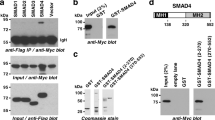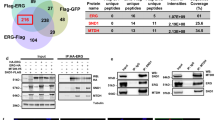Abstract
Deregulated expression of ETS transcription factors has emerged as an important event in prostate cancer pathogenesis. Here we show that the expression of epithelial-specific ETS (ESE)-3 factor is frequently reduced at the RNA and protein level in prostate cancer clinical samples compared to normal prostate. In PC3 and DU145 cells, ESE-3 was silenced by methylation of an evolutionarily conserved CpG site in its promoter and treatment with 5-aza-2′-deoxycytidine restored its expression. In a prostate epithelial cell transformation model, methylation of this site was inversely correlated with ESE-3 expression and occurred only in Ras-transformed and tumorigenic cells and not in normal and immortalized cells suggesting that ESE-3 silencing was functionally linked to oncogenic transformation. Consistent with a tumor suppressor function, re-expression of ESE-3 in prostate cancer cells inhibited clonogenic survival and induced apoptotic cell death. ESE-3 increased the level of procaspase-3, a key element in the apoptotic cascade. This effect was mediated at the transcriptional level by direct binding of ESE-3 to the caspase-3 promoter. Collectively, our findings implicate ESE-3 as a candidate tumor suppressor in prostate cancer. Decreased expression of ESE-3 may result in loss of important regulatory mechanisms in prostate epithelial cells and contribute to the pathogenesis of prostate cancer.
This is a preview of subscription content, access via your institution
Access options
Subscribe to this journal
Receive 50 print issues and online access
$259.00 per year
only $5.18 per issue
Buy this article
- Purchase on Springer Link
- Instant access to full article PDF
Prices may be subject to local taxes which are calculated during checkout






Similar content being viewed by others
References
Baylin SB, Ohm JE . (2006). Epigenetic gene silencing in cancer—a mechanism for early oncogenic pathway addiction? Nat Rev Cancer 6: 107–116.
Berger R, Febbo PG, Majumder PK, Zhao JJ, Mukherjee S, Signoretti S et al. (2004). Androgen-induced differentiation and tumorigenicity of human prostate epithelial cells. Cancer Res 64: 8867–8875.
Carbone GM, Napoli S, Valentini A, Cavalli F, Watson DK, Catapano CV . (2004). Triplex DNA-mediated downregulation of Ets2 expression results in growth inhibition and apoptosis in human prostate cancer cells. Nucleic Acids Res 32: 4358–4367.
Catapano CV, McGuffie EM, Pacheco D, Carbone GM . (2000). Inhibition of gene expression and cell proliferation by triple helix-forming oligonucleotides directed to the c-myc gene. Biochemistry 39: 5126–5138.
Gonzalgo ML, Hayashida T, Bender CM, Pao MM, Tsai YC, Gonzales FA et al. (1998). The role of DNA methylation in expression of the p19/p16 locus in human bladder cancer cell lines. Cancer Res 58: 1245–1252.
Igney FH, Krammer PH . (2002). Death and anti-death: tumour resistance to apoptosis. Nat Rev Cancer 2: 277–288.
Jones B, Chen J . (2006). Inhibition of IFN-gamma transcription by site-specific methylation during T helper cell development. EMBO J 25: 2443–2452.
Kang JH, Kim SJ, Noh DY, Park IA, Choe KJ, Yoo OJ et al. (2001). Methylation in the p53 promoter is a supplementary route to breast carcinogenesis: correlation between CpG methylation in the p53 promoter and the mutation of the p53 gene in the progression from ductal carcinoma in situ to invasive ductal carcinoma. Lab Invest 81: 573–579.
Kas K, Finger E, Grall F, Gu X, Akbarali Y, Boltax J et al. (2000). ESE-3, a novel member of an epithelium-specific ETS transcription factor subfamily, demonstrates different target gene specificity from ESE-1. J Biol Chem 275: 2986–2998.
Laslo P, Spooner CJ, Warmflash A, Lancki DW, Lee HJ, Sciammas R et al. (2006). Multilineage transcriptional priming and determination of alternate hematopoietic cell fates. Cell 126: 755–766.
Liu AY, Corey E, Vessella RL, Lange PH, True LD, Huang GM et al. (1997). Identification of differentially expressed prostate genes: increased expression of transcription factor ETS-2 in prostate cancer. Prostate 30: 145–153.
Liu W, Wang G, Yakovlev AG . (2002). Identification and functional analysis of the rat caspase-3 gene promoter. J Biol Chem 277: 8273–8278.
Nelson WG, De Marzo AM, Isaacs WB . (2003). Prostate cancer. N Engl J Med 349: 366–381.
Oikawa T, Yamada T . (2003). Molecular biology of the ETS family of transcription factors. Gene 303: 11–34.
Pei H, Li C, Adereth Y, Hsu T, Watson DK, Li R . (2005). Caspase-1 is a direct target gene of ETS1 and plays a role in ETS1-induced apoptosis. Cancer Res 65: 7205–7213.
Petrovics G, Liu A, Shaheduzzaman S, Furasato B, Sun C, Chen Y et al. (2005). Frequent overexpression of ETS-related gene-1 (ERG1) in prostate cancer transcriptome. Oncogene 24: 3847–3852.
Pogribny IP, Pogribna M, Christman JK, James SJ . (2000). Single-site methylation within the p53 promoter region reduces gene expression in a reporter gene construct: possible in vivo relevance during tumorigenesis. Cancer Res 60: 588–594.
Robertson KD, Hayward SD, Ling PD, Samid D, Ambinder RF . (1995). Transcriptional activation of the Epstein-Barr virus latency C promoter after 5-azacytidine treatment: evidence that demethylation at a single CpG site is crucial. Mol Cell Biol 15: 6150–6159.
Rosenbauer F, Wagner K, Kutok JL, Iwasaki H, Le Beau MM, Okuno Y et al. (2004). Acute myeloid leukemia induced by graded reduction of a lineage-specific transcription factor, PU.1. Nat Genet 36: 624–630.
Schedin PJ, Eckel-Mahan KL, McDaniel SM, Prescott JD, Brodsky KS, Tentler JJ et al. (2004). ESX induces transformation and functional epithelial to mesenchymal transition in MCF-12A mammary epithelial cells. Oncogene 23: 1766–1779.
Sementchenko VI, Watson DK . (2000). ETS target genes: past, present and future. Oncogene 19: 6533–6548.
Seth A, Watson DK . (2005). ETS transcription factors and their emerging roles in human cancer. Eur J Cancer 41: 2462–2478.
Tomlins SA, Mehra R, Rhodes DR, Smith LR, Roulston D, Helgeson BE et al. (2006). TMPRSS2:ETV4 gene fusions define a third molecular subtype of prostate cancer. Cancer Res 66: 3396–3400.
Tomlins SA, Rhodes DR, Perner S, Dhanasekaran SM, Mehra R, Sun XW et al. (2005). Recurrent fusion of TMPRSS2 and ETS transcription factor genes in prostate cancer. Science 310: 644–648.
Tugores A, Le J, Sorokina I, Snijders AJ, Duyao M, Reddy PS et al. (2001). The epithelium-specific ETS protein EHF/ESE-3 is a context-dependent transcriptional repressor downstream of MAPK signaling cascades. J Biol Chem 276: 20397–20406.
Tummala R, Sinha S . (2006). Differentiation-specific transcriptional regulation of the ESE-2 gene by a novel keratinocyte-restricted factor. J Cell Biochem 97: 766–781.
Acknowledgements
This work was supported by grants from Swiss Cancer League and the Tessin Foundation for Cancer Research to GMC and Compagnia di San Paolo, Turin, IT, to GC. RC, AM and MMG were supported by fellowships from the San Salvatore Foundation, ESO and FIRC, respectively. RC is enrolled in the PhD program in Pharmaceutical Sciences of the University of Geneva, Switzerland. We thank WC Hahn for the immortalized and transformed PrECs, A Tugores for the pRc/CMV-ESE3b-FLAG plasmid and anti-ESE-3 antibody, DK Watson for the pSGK-ETS-2 plasmid, AG Yakovlev for the pGL3-CASP3 plasmid.
Author information
Authors and Affiliations
Corresponding author
Additional information
Supplementary Information accompanies the paper on the Oncogene website (http://www.nature.com/onc).
Supplementary information
Rights and permissions
About this article
Cite this article
Cangemi, R., Mensah, A., Albertini, V. et al. Reduced expression and tumor suppressor function of the ETS transcription factor ESE-3 in prostate cancer. Oncogene 27, 2877–2885 (2008). https://doi.org/10.1038/sj.onc.1210953
Received:
Revised:
Accepted:
Published:
Issue Date:
DOI: https://doi.org/10.1038/sj.onc.1210953
Keywords
This article is cited by
-
The urothelial gene regulatory network: understanding biology to improve bladder cancer management
Oncogene (2024)
-
Loss of EHF facilitates the development of treatment-induced neuroendocrine prostate cancer
Cell Death & Disease (2021)
-
AKR1C3 is a biomarker and druggable target for oropharyngeal tumors
Cellular Oncology (2021)
-
Circulating extracellular vesicles release oncogenic miR-424 in experimental models and patients with aggressive prostate cancer
Communications Biology (2021)
-
Deducing signaling pathways from parallel actions of arsenite and antimonite in human epidermal keratinocytes
Scientific Reports (2020)



